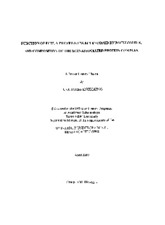| dc.description.abstract | Baculovirus codes for a unique, multifunctional cyclin, EC27. EC27 is a structural component of the virus. We hypothesize that EC27 manipulates the host cell cycle in the early stages of infection; as a structural protein, EC27 is introduced into the cell immediately as the virus enters the cell. In the insect midgut, the site of primary infection, baculovirus must induce cell cycle progression from G0 into S-phase so that the host's DNA synthesis machinery is available for viral DNA replication. We know that EC27 can form active complexes with cdk6, the catalytic component of the cyclin kinase complex that regulates progression from G0 to S-phase. Infection of in vitro cell culture results in a cell cycle arrest later in infection in which at least 80-90% of the cell population remains in G2/M phase. We also know that EC27 can form active complexes with cdc2, the catalytic component of the cyclin kinase complex that regulates progression through M-phase. Thus, baculovirus infection results in manipulation of at least two points in the host cell cycle. Curiously, EC27 binds key regulatory elements of those two cell cycle checkpoints. We speculate that abrogation of these cell cycle checkpoints is accomplished by the function of virus-encoded proteins. The EC27-associated complex's activity, with its cyclin D-like (forming active complexes containing cdk6) and cyclin B-like function (forming active complexes containing cdc2), and EC27's amino-acid sequence homology with several cellular cyclins make EC27 a likely suspect as a viral protein involved in cell cycle manipulation during infection. A yeast two-hybrid screen identified another baculovirus structural protein, ORF101, as an EC27 interacting protein. We confirmed this interaction by western blot and demonstrated that ORF101 can be detected in immune complexes precipitated with EC27 antisera. ORF101 contains a pRB-binding motif; several oncogenes from DNA tumor viruses, such as the E1A gene product from adenovirus, use pRB-binding proteins to induce proliferation from G0 into S-phase. Similar models of EC27/ORF101 function in cell cycle manipulation associated with baculovirus infection can be imagined. Our aim is two-fold: 1. To determine if EC27 is a functional cyclin, which we are approaching by yeast complementation, and 2. To determine the identity of the other EC27 binding partners, of both cellular and viral origin, which we are approaching through immunoprecipitation experiments. We hope to determine if EC27 is displacing or acting in parallel with cellular cyclins in these EC27-associated complexes that have cyclin kinase activity. These experiments typify a new trend in virology research: accentuating the complex virus-host interactions of viral genes and gene products with the host cell molecular environment. | en |


